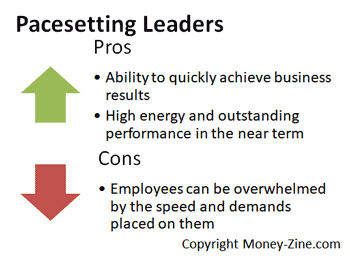The pacesetting leader was first described by Daniel Goleman in conjunction with the six leadership styles defined in his theory of Emotional Intelligence. While there are documented situations where this style is effective, it's important to use it sparingly.
Attributes of Pacesetting Leaders
The phrase that best describes the operating mode of the pacesetting leader is: "Do as I do, now." That's because this style is one that involves a drive to achieve initiatives, and a drive to achieve results.
| Additional Resources |
| Coaching Leadership Coercive Leadership Democratic LeadershipTrait Theory of Leadership |
The pacesetting leader sets both high standards for themselves and those they are leading. One of the key attributes of this style is the "lead by example" approach. They don't ask their followers to do anything they wouldn't do themselves. Unfortunately, not everyone shares the same motivating forces. Pacesetting leaders are also quick to identify individuals that are not keeping pace with their expectations. Poor performers are asked to rise to the occasion, and if they do not, they are quickly replaced. Pacesetters don't give employees a lot of positive feedback; they simply don't have the time. On the flip side, they have no problem jumping right in and taking over if they think progress is too slow.
Pros and Cons
Clearly one of the pros of the pacesetting leadership style is they are able to quickly achieve business results. In the short term, there will be a high-energy group with outstanding performance in terms of accomplishing tasks as well as the quality of the work itself.

On the down side, the style has a negative effect on the work environment. In fact, only the coercive leadership style has a greater negative effect on people. Oftentimes employees are simply overwhelmed by the speed and the demands placed upon them, resulting in morale that quickly deteriorates. To make matters worse, the haste under this leadership style is such that instructions to followers may not even be clear. Ironically, the leader has no patience for those that need to learn, or are not picking up new work fast enough.
Effectively Using the Style
The most effective way to use the pacesetting style is when a business or department is in need of quick results from a group that is already highly motivated and competent. This means the motivation that's driving the leader must also exist among the followers. The style is also effective when group members are highly competent in the task they are going to complete. Whether this comes from aptitude or experience, the group members are going to be asked to work quickly. There is no time to learn on the job, or teach someone a skill they may be lacking. While the pacesetting style can be very effective in getting results in the short term, it's not a style that can be used over the long haul. Quite frankly, pacesetters are great at burning out their coworkers. The pacesetting style can be very effective if used sparingly; when it's really needed for the good of the business. If used as a base leadership style, the turnover rate on the team may be high.
Examples of Pacesetting Leaders
Perhaps the best examples of pacesetting leaders come from the military. Under the circumstances encountered in that environment, it's important to make quick and decisive moves. There is very little tolerance for making mistakes when the stakes are that high. The second example of a pacesetting leader comes from the business world, and is perhaps the most recognizable and studied CEO of all time.
Jack Welch
He began his career at General Electric in 1960, and by 1981 Jack Welch was named the company's eighth Chief Executive Officer. While Jack was also known for his informal approach that allowed him to interact with employees at all levels in his organization, he was also a persistent and demanding executive. In fact, from the period 1981 to 1985 he played a role in cutting approximately 25% of the jobs from the payroll at GE. That's nearly 100,000 employees. It was during this time he was dubbed "Neutron Jack." Jack Welch believed that leaders should avoid micro-managing, and spend their time inspiring others. He was a firm believer in leading by example, which is a characteristic of the pacesetting leadership style. Finally, he believed in what he termed the four E's of leadership: energy, energize, edge, and execution. Jack Welch retired from GE in 2001 after publishing his best selling autobiography: Jack - Straight from the Gut.
About the Author - Pacesetting Leadership



.jpg)